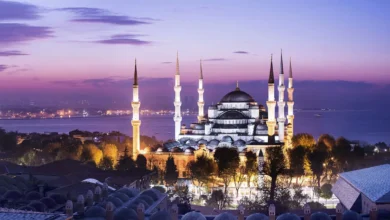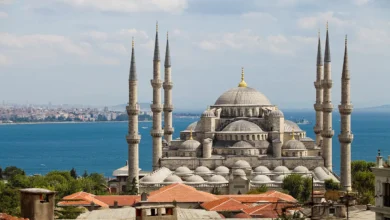
The Jameh Mosque of Yazd is a historic and architectural masterpiece, representing the grandeur of Islamic architecture in Yazd, Iran. Known for its breathtaking design, intricate tilework, and monumental structure, it stands as a testament to Iran’s rich cultural heritage and religious history.
As one of the most significant mosques in Iran, the Jameh Mosque of Yazd has played a central role in the city’s religious and social life for centuries. This mosque is not only a place of worship but also a symbol of the architectural prowess of the Timurid era. Its inclusion on UNESCO’s World Heritage list further emphasizes its importance as a cultural and historical treasure.
History of Jameh Mosque of Yazd
The Jameh Mosque of Yazd has a long and intricate history, having been built and renovated over several centuries during different historical periods. The mosque has undergone extensive changes and reconstructions during the Ilkhanid, Safavid, Timurid, Muzaffarid, and Qajar dynasties.
Foundation of the Jameh Mosque dates back to the Sassanid era, built on the site of an ancient fire temple. The current structure of the mosque dates from the Qajar period, when widespread demolitions and renovations under Fath Ali Shah Qajar gave the mosque its present appearance.

Jameh Mosque Atiq
The first mosque built on this site was Jameh Mosque Atiq, constructed during the 3rd century AH under the rule of Amr al-Layth Saffari. In the 5th century AH, this mosque was repaired and a minaret was added, which remained standing for centuries.
Jameh Mosque Qadeem
In the 5th century AH, Ala’ al-Dawla, one of the rulers of Yazd, constructed the Jameh Mosque Qadeem, adding a dome and arcades to the initial mosque. Later, the daughters of Faramarz bin Kaku’i built additional sections, including a prayer hall and tomb near the second mosque.
Jameh Mosque Now
In the early 8th century AH, the Jameh Mosque Now was constructed with a small courtyard, dome, and a large iwan. The mosque was built by Rukn al-Din Muhammad bin Qavam al-Din Muhammad bin Nizam Hosseini Yazdi, with his efforts and continuous follow-up. However, Rukn al-Din passed away before its completion. The dome and iwan were finished in 732 AH by Sharaf al-Din Ali Yazdi.
In 777 AH, during the reign of Amir Timur, the dome and iwan were decorated with tile work. Khwaja Jalal al-Din Mahmoud Khwarazmi, the son of Amir Timur, added a calligraphic inscription in Naskh script around the dome and iwan, which included Surah Al-Fath. This inscription was not completed by Khwaja Jalal but was finished by Nizam Kermani in 819 AH during the reign of Shahrokh Mirza. That same year, Shahrokh ordered the installation of another inscription at the mosque’s entrance with the names of the Twelve Imams and his own titles.
This rich history reflects the architectural transformations and importance of the Jameh Mosque of Yazd, making it one of the most significant examples of Islamic architecture in Iran and Yazd.
Architecture of Jameh Mosque of Yazd

Exterior Design and Structure:
The Jameh Mosque of Yazd is a stunning example of Islamic architecture, with a grand entrance and an expansive portal that welcomes visitors. The mosque’s exterior features intricate brickwork, characteristic of the region’s architecture, and a large, open courtyard that is typical of Persian mosques. The surrounding structures enhance the mosque’s spiritual and architectural significance, blending seamlessly with the desert environment.
Minarets:
The mosque is known for its two towering minarets, which stand as some of the tallest in Iran. Reaching heights of approximately 48 meters, these minarets serve as both religious symbols and architectural masterpieces. The minarets are adorned with beautiful tile mosaics and geometric patterns, offering an imposing yet graceful presence on the Yazd skyline.
Dome and Vaults:
The mosque’s dome is a key architectural feature, designed with elegant precision. Built using traditional Persian techniques, the dome’s design allows for excellent acoustics within the prayer hall. The use of intricate tilework and light, airy vaults accentuates the visual harmony, while the dome’s shape and decoration reflect classical Persian aesthetics, making it one of the finest examples of Islamic dome construction in the region.
Interior Design:
The interior of Jameh Mosque is equally breathtaking, featuring exquisite tilework, stucco decoration, and geometric patterns that are central to Persian Islamic architecture. The walls are adorned with calligraphy, and the colors of the tiles range from vibrant blues to earthy tones, creating a sense of tranquility and reverence. The interior design highlights the mosque’s historical and religious importance, with each detail carefully crafted to enhance the spiritual atmosphere.
Courtyard and Gardens:
The mosque is surrounded by a serene courtyard, designed to be a peaceful space for reflection and prayer. Central to the courtyard is a large fountain, which provides a calming sound and adds to the mosque’s aesthetic beauty. The courtyard also features lush gardens that enhance the mosque’s harmony with the natural environment, offering visitors a quiet retreat in the heart of the city.
Key Features and Attractions

Grand Courtyard and Arches:
The Jameh Mosque of Yazd is renowned for its expansive grand courtyard, which serves as a tranquil space for reflection and prayer. Surrounded by beautiful arcades, the courtyard is an architectural masterpiece, showcasing the unique blend of Persian and Islamic styles. The arched walkways, with their graceful curvature and detailed brickwork, offer a sense of balance and grandeur. These arches are not just decorative but serve as structural elements that enhance the mosque’s stability and beauty.
Prayer Hall:
The mosque’s prayer hall is one of its most striking features. The hall is spacious, adorned with intricate tilework and a large mihrab (prayer niche), which is the focal point of the prayer hall. The mihrab is richly decorated with Islamic geometric patterns and calligraphy, drawing the eye upwards toward the magnificent dome. The prayer hall’s design ensures that worshippers experience both physical and spiritual comfort, making it a centerpiece of the mosque’s architectural design.
Mausoleum within the Mosque:
Located within or near the mosque is a significant mausoleum that holds the tombs of notable figures, including religious leaders and patrons. The presence of these tombs adds to the mosque’s sacred and historical significance. While the exact tombs may vary, these burial sites are important as they connect the mosque with Yazd’s long religious and cultural history, enriching the spiritual atmosphere of the mosque.
Water System and Persian Gardens:
The Jameh Mosque of Yazd integrates traditional Persian water systems, such as qanats and fountains, into its design. These water systems, which are a hallmark of Persian architecture, not only provide functional value but also symbolize life and purity. The fountains in the mosque’s courtyard add to the serenity of the space, creating a soothing ambiance. The Persian gardens, carefully designed to incorporate water and greenery, further enhance the mosque’s beauty, offering visitors a peaceful space to relax and reflect.

Museum of Jameh Mosque of Yazd
The Museum of Jameh Mosque of Yazd began its operations in 2014 (1393 in the Persian calendar) with the goal of displaying historical artifacts related to the customs and culture of ancient times, particularly during the Islamic period. Another key objective of the museum is to introduce the mosque’s history and highlight the restoration and reconstruction efforts over time. The museum collection consists of 350 pieces, spanning from the Ilkhanid period to the contemporary era. Some of the notable artifacts include:
- Photographs of Jameh Mosque from 1933 (1312 in the Persian calendar) onward.
- Some remnants from the restorations carried out over the years.
- Golden tiles from the Ilkhanid period, dating back to the 8th century in the Persian calendar.
- Mosaic tiles from the Timurid period, dating back to the 9th century in the Persian calendar.
- Seven-colored tiles from the Qajar period.
- Mosaic tiles from the Pahlavi I era.
- A marble stone pulpit from the Qajar period.
- A wooden clock of the mosque, donated by Haj Mohammad Ali Vaziri in 1945 (1324 in the Persian calendar).
- A collection of Zilu (traditional Persian carpets).
- A piece of the Kaaba’s curtain, donated by the King of Saudi Arabia in 1966 (1345 in the Persian calendar).
- A walnut wood door with intricate carved decorations from the Afsharid period.

Practical Information for Visitors
General Information:
The Jameh Mosque of Yazd is open to visitors every day. The mosque is a popular tourist destination, and the typical visiting hours are from 8:00 AM to 6:00 PM. Entry to the mosque is usually free for local visitors, though tourists may need to pay a small fee. Accessibility is quite convenient, with the mosque being centrally located in Yazd’s old town. Parking options are available near the mosque, and public transportation, such as local buses or taxis, can easily take visitors to the mosque.
Travel Tips:
- Best Time to Visit Yazd: The ideal time to visit Yazd is during the cooler months, from March to May and September to November, when the weather is more pleasant. Summers can be extremely hot, with temperatures often exceeding 40°C (104°F).
- Travel from Tehran or Shiraz: Yazd is well-connected to major Iranian cities. If you’re traveling from Tehran, you can either take a domestic flight (about 1 hour) or travel by bus or car (approximately 6-7 hours). From Shiraz, Yazd is around a 4-hour drive, making it an easy road trip.
- Distance from Major Cities: Yazd is roughly 320 km (200 miles) from Shiraz and about 620 km (385 miles) from Tehran.
Local Markets and Souvenirs:
Yazd is famous for its traditional handicrafts, and visitors to the Jameh Mosque of Yazd can explore several nearby bazaars. The Yazd Grand Bazaar is a perfect place to shop for pottery, handwoven textiles, Persian carpets, and copperware. Don’t miss out on purchasing traditional Yazdi sweets, such as Qotab and Pashmak. These items make for great souvenirs that reflect the rich cultural heritage of Yazd.
Historical and Cultural Significance

Role in Yazd’s Heritage:
The Jameh Mosque of Yazd holds a central place in the city’s development as a hub of Islamic culture and religion. Built during the Seljuk period, the mosque has long been a place for worship and community gathering, symbolizing the heart of Yazd’s Islamic heritage. Over centuries, the mosque played a key role in religious education, becoming a focal point for Islamic scholars and theologians. Additionally, its location in Yazd, historically a center of trade along the Silk Road, reflects its importance not only as a religious site but also as a symbol of the city’s prosperity and cultural exchange.
Influence on Persian Architecture:
The Jameh Mosque of Yazd is a masterpiece of Persian Islamic architecture. Its unique design, characterized by its grand entrance portal, minarets, dome, and intricate tilework, has greatly influenced the architecture of other mosques and Islamic buildings throughout Iran. The mosque’s architectural style, blending Seljuk, Safavid, and Qajar elements, serves as a reference for later mosque constructions, both in Yazd and beyond. Its influence can be seen in the design of domes, mihrabs, and courtyards in mosques across the country, making it a key figure in the evolution of Iranian Islamic architecture.
UNESCO Recognition:
The Jameh Mosque of Yazd is an integral part of the city’s UNESCO World Heritage status, which was granted in 2017. Yazd, as one of the world’s best-preserved cities in the desert, showcases traditional Persian architecture and urban planning that have stood the test of time. The mosque contributes significantly to this recognition, reflecting the city’s rich historical, religious, and architectural heritage. As part of Yazd’s cultural legacy, the mosque stands as a living testament to the city’s longstanding role in the development of Iranian culture and architecture.






